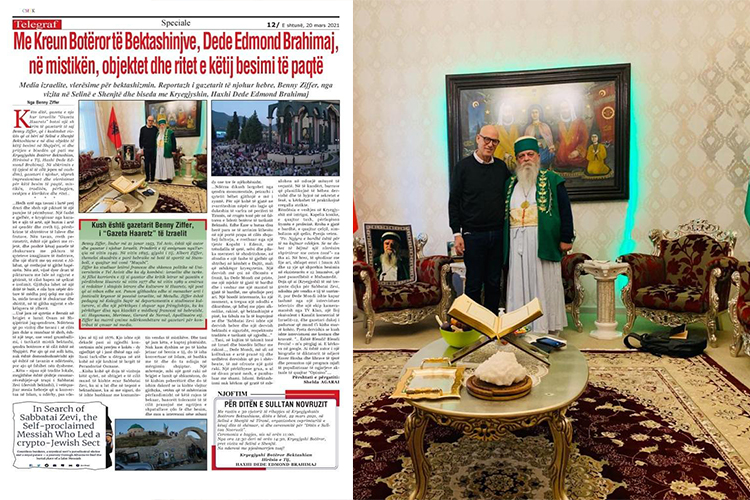
With the World Leader of the Bektashis, Dede Edmond Brahimaj, on the mystique, objects and rites of this peaceful faith
By Benny Ziffer
These days, the well-known Israeli newspaper “Haaretz” published an article by its journalist Benny Ziffer, dedicated to his visit to the Bektashi Holy See and some objects of this faith in Albania, as well as the reception and conversation he had with the Bektashi World Leader, His Grace, Haxhi Dede Edmond Brahimaj. In his article (parts of which are given below), the well-known journalist expresses his impressions and appreciations for this peaceful faith, mysticism, tradition, spread, clerical dress and rites.
* * *
I cast my eyes up at the high wooden ceiling and see a painting of an upside-down paradise. A green field crisscrossed by canals of golden water, a golden fountain in the center and around it depictions of flowerbeds and fruits. Below the ceiling, around the perimeter, is a latticed gallery, and below that panels decorated with paintings of imaginary dream cities, and a strip with the 99 names of Allah encircling the entire space. Under that come wooden doors painted with flowers in the colors of joy, which open into cells of seclusion. Everything is bathed in a soft light which enters through large stained-glass windows, between the decorated ceiling and the strip, in all the splendid colors of the rainbow.
I am in the city of Berat on the banks of the River Osum in south-central Albania. The building I’m visiting, and whose ceiling I am straining to see, is a tekke, or gathering place, of the Bektashi Sufi order, a mystical Muslim sect whose world center is in Albania. But what brought me here is not necessarily what’s on the ceiling of the building but what’s hidden beneath the floor. It’s here – according to one local tradition, although it is a matter of dispute – that the body of Sabbatai Zevi, the self-styled Jewish messiah who converted to Islam, was interred, after his death in 1676. That was a decade after he chose conversion over decapitation – the two choices supposedly given him by the Turkish sultan – and was sent to what was then a remote province of the Ottoman Empire.
I had long wanted to visit this city, in whose lanes Sabbatai Zevi may well have walked, in whose mosques he prayed and in whose Bektashi tekke he would surely have joined the local community of mystics. And now that I’m here, I understand him completely. I have no doubt that had I lived in his generation I would have converted to Islam along with him and followed him into Albanian exile. Of an evening, over a glass of raki on the banks of the foaming river, we would have sighed and agreed that it had all been worth it just to finally arrive in this blessed region, whose tolerant residents accept with a shrug of the shoulders every religion and creed, and don’t care if you uphold two or three religions simultaneously.
“Until three years ago, everything here was very neglected,” I’m told by Koran – the name of the tekke’s security guard – but then salvation arrived. It took the form of a special delegation of artists and other experts from the Turkish Cooperation and Coordination Agency, a government body with many resources at its disposal, which received the go-ahead from President Recep Tayyip Erdogan to restore Turkey’s glory in the world, and to restore and renovate Ottoman heritage sites everywhere. Not long ago, the house where Sabbatai Zevi was born, in Izmir, was magnificently restored, and now the turn had come of his conjectured grave in Berat.
So I’m standing in the tekke of the Bektashi order, also called the Halveti Brotherhood, having a hard time taking my eyes off the ceiling, when suddenly I feel deeply moved because I realize I’ve already seen these designs of flowers and fruits. And I even remember where: in the illustrations for a Tu Bishvat seder in the Sabbatean sect that the children of my friend Sevin – who were fed up with the secrecy imposed on that group – showed me. Yes, the Sabbateans have a special Haggadah of their own, which sets forth the rules of Jewish Arbor Day, which they call Rosh Hashanah La’Ilan, ilan being the Hebrew for “tree” – as Sabbatai Zevi himself was called.
The Bektashis are a branch of Shi’a Islam that has, according to its world leader, Baba Mondi (Edmond Brahimaj), 150 million believers. “They were reputed to be Muslims in outward appearance only, and to practice among themselves libertinism and the ‘freedom’ of the children of the spirit,” wrote Gershom Scholem, the great scholar of Sabbateanism. Scholem maintained that Sabbatai Zevi was deeply influenced by the Bektashi community; after all, the Sufi sect practices their mystical rites in secret, as do Sabbateans, but act in everyday life as regular Muslims. Indeed, in a letter Sabbatai Zevi wrote from Albania in marvelous Hebrew in 1673, seven years after converting to Islam himself, he instructed his believers: “Chop off utterly the branches of that faith till nothing remains buried in your hearts but the root alone… Bury this my very great faith.”
Isn’t it logical, then, to accept the local notion that the body of Sabbatai Zevi was indeed interred beneath the floor of the Bektashi tekke after his death in 1676?
As one moves away from the monumental center, the cityscape becomes ever gloomier. For a long time we crawled through what appeared to be poverty-stricken neighborhoods on the outskirts of Tirana on our way to the shrine of the world leader of the Bektashi order. Even Waze got confused a few times before we reached the turn to a gate behind which loomed the shrine, surrounded by another Garden of Eden of tranquil roses and cypresses and glistening marble tiles, against the background of a verdant plain stretching to the foot of the Dajti, the mountain that overlooks the capital. A dervish led me to the throne room, where the Baba awaited me, with a long white beard and attired in a long white robe with gold embroidery.
I’d already met the Baba before. That was 15 years ago, when he was a guest of the Herzliya Artists’ Residence, directed by the poet Varda Ginosar. Albania had then barely shaken off 50 years of a murderous communist dictatorship. In the dimly lit hall appeared a man wearing a conical green hat of a dervish, while by his side musicians played doleful Turkish melodies. The Bektashis, he said, contrary to other Muslims, permit the drinking of wine and also allow coed worship, and an understanding of the principles of Bektashism is arrived at in part through jokes. On that occasion he shared one with us:
Now that I’m here, I understand Sabbatai Zevi completely. I have no doubt that had I lived in his generation I would have converted to Islam along with him and followed him into Albanian exile.
“An imam is preaching in the mosque about the evils of alcohol and asks the believers: If you hold a pail of water and a pail of raki in front of a donkey, which will it drink? The water, the Bektashi replies. Indeed, the imam asserts. And why does he drink the water? Because he’s an ass, the Bektashi replies.” He then replied to a question from the audience: “Sabbatai Zevi was a Jewish dervish and a Muslim dervish and bridged between the two religions.”
Now, in memory of our meeting in Israel, and in memory of the donkey that didn’t drink raki, Baba Mondi seated me on the golden armchair next to him and commanded the dervish who was serving him to offer me a glass of raki. An interpreter, a woman, sat on the sofa next to us, bareheaded. Bektashi Islam does not require women to cover themselves in any special way. In contrast, the men who plan to become dervishes and enter into the secrets of the religion are required to practice abstinence from women.
The significance of the Baba’s garb intrigued me. The conical hat, called a taj, represents the spirit of prophecy. The long white robe, called a çefçil, symbolizes a shroud. I wondered.
“Yes,” he said. “The color white comes to remind us of death. That we must do spiritual stocktaking with ourselves. On the belt, embroidered with gold threads, appear the name of the imam Ali and 12 stars expressing belief in the existence of 12 imams who are Mohammed’s successors. The 12th imam disappeared and is destined to return at the end of days.”
Baba Mondi glanced at his watch. Another interview awaited. He led me through the rose garden to the Bektashis’ museum and hastily explained several of the exhibits. The vast cauldron and the huge wooden spoons in it are used to prepare ashure, a pudding made from 10 types of grains, lentils and dried fruits, and eaten on the Ashura, which marks the murder of Hussein and Hassan, Ali’s sons, in the Battle of Karbala in 680 C.E. I wanted him to tell me something about Sabbatai Zevi, maybe about his place of burial, but Baba Mondi had already been grabbed by a television interviewer and a crew of cameramen from TV Klan, a kind of equivalent of Israel’s commercial Channel 12, and he seemed irked that I’d taken up his time. I asked my dervish escort who the interviewer in the suit and tie was. “You don’t recognize him? It’s Blendi! Blendi Fevziu!” he replied, looking at me in amazement. I googled him. He is the author of a biography of the late dictator Enver Hoxha and other books, and hosts a highly popular current-events program called “Opinion.”
DETAIL
Who is the journalist Benny Ziffer, of the “Gazeta Haaretz” of Israel
Benny Ziffer, born January 21, 1953, Tel Aviv, is a well-known Israel author and journalist. His parents emigrated from Turkey in 1949. In 1895, his grandfather, Albert Ziffer, founded the world’s first Jewish sports team in Istanbul, later called the Maccabi.
Ziffer studied French literature and political science at Tel Aviv University and has two nationalities: Israeli and Turkish. He began his career as a journalist and literary critic in the daily newspaper Haaretz in 1977 and in 1989 was appointed Editor of the Haaretz literary and cultural supplement, a post he still holds today. He also works as the art manager of the main Israeli poetry festival, in Metulla. Ziffer is a lecturer at Sapir College in the department of cultural studies, as well as a prominent translator from French, where he has translated some of the great French classics into Hebrew, such as: Huysmans, Merimee, Gerard de Nerval, Apollinaire, etc. Ziffer has received international awards in journalism for his valuable contribution to the media.
Adapted and prepared:
Shelda AGARAI
